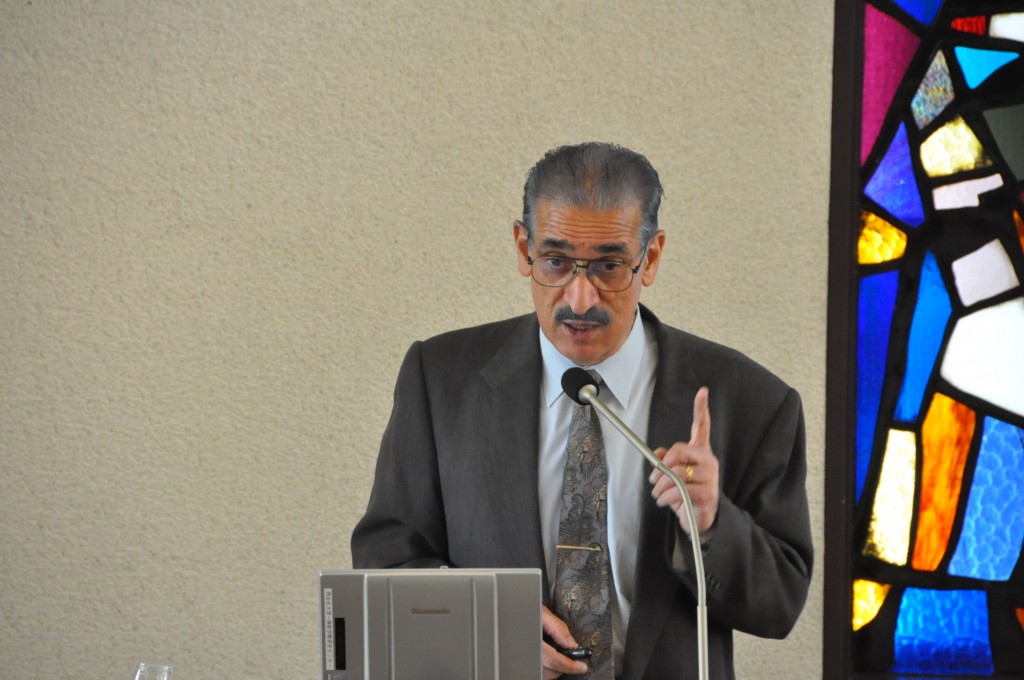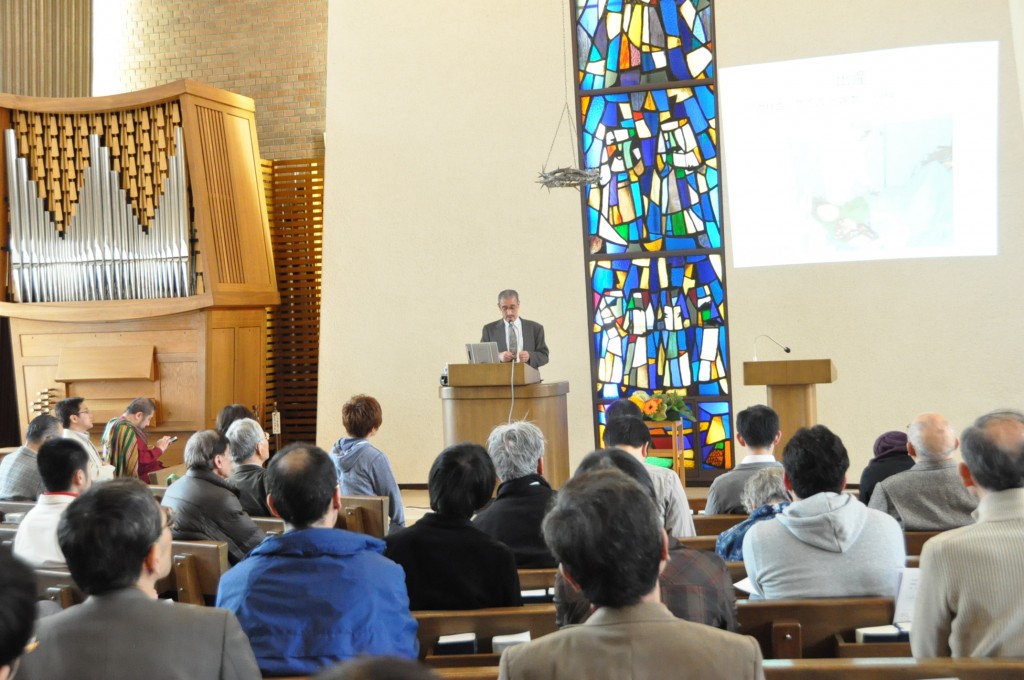Center for Interdisciplinary Study of Monotheistic Religions(CISMOR)Doshisha University
> Public Lectures > Present Situation of Afghanistan and the Activity of the NGO Karez Health & Educational ServicesPublic Lectures
CISMOR Public Symposium
Present Situation of Afghanistan and the Activity of the NGO Karez Health & Educational Services
| Date: |
2012/04/14 15:00− 16:45 |
|---|---|
| Place: | Divinity Hall Chapel, Imadegawa Campus, Doshisha University |
| Lecture: | Khaled Reshad, Doctor / Executive Director of Karez Health & Educational Service |
| Summary: | |
|
【Program】 ・Lecture by Dr. Khaled Reshad ・Panel Discussion with Dr. Khaled Reshad, Dr. Hassan Ko Nakata Moderated by Prof. Masanori Naito, Graduate School of Global Studies Dr. Khaled Reshad began his lecture by showing photos of Afghanistan in the past, with its beautiful green environment. In 1979, Afghanistan was invaded by 130,000 Soviet troops and placed under the control of the Soviet Union. Human losses incurred during the military regime of the Soviet Union, which lasted until the final troop withdrawal in 1989, are estimated to be between 1,000,000 and 1,500,000. Moreover, 500,000 lives are said to have been lost between 1994, when a civil war started in Afghanistan, and 1996, when the Taliban regime was established. Prior to withdrawal, Soviet troops laid 20 million land mines in Afghanistan, of which 8 million still remain buried throughout the country. While each land mine is very small and can be manufactured for only 400 yen or so, it costs as much as 100,000 yen to remove one land mine. Another problem that threatens this country is that of cluster bombs. A cluster bomb explodes in mid-air and releases approximately 2,000 sub-munitions, many of which are left on the ground and explode themselves, disabling people of working age and injuring many people, including children. Dr. Reshad is going to invite Afghan people who have lost legs to land mines to Nara, in order to fit them with prosthetic legs. Some data also shows that depleted uranium shells have caused the number of birth defects to increase sevenfold. The situation of Afghanistan still remains far from being safe, with armored vehicles roaming the streets and threatening people. The number of deaths of Afghan civilians has increased steadily since 2006, and 3,021 were killed in 2011 alone. According to the data collected by Dr. Reshad, many Afghan children suffer malnutrition, and both boys and girls weigh less than the average. Afghanistan’s GNI per capita in 2007 is 250 dollars (against Japan’s 39,632 dollars), the number of infant deaths per population of 1,000 is 165 (against Japan’s 1.2), the number of deaths of children under five years of age per population of 1,000 is 257 (against Japan’s 0.7), and the number of deaths of pregnant women per 100,000 childbirths is 1,600 (against Japan’s 35). As these figures show, death is part of everyday life in Afghanistan. Tuberculosis still remains a life-threatening disease: 70,000 people newly contract tuberculosis and 20,000 die from the disease each year, while the number of new patients per population of 100,000 is estimated at 333. In Afghanistan, 2,203 doctors are available, of whom 1,598 are male and 605 are female. The number of doctors per population of 100,000 is 8.12 (against Japan’s 198). There are not enough doctors and medical schools, and most of them are based in urban areas—which is deeply problematic. The elementary school enrollment rate has been increasing in recent years, reaching 74% for boys and 46% for girls, but the secondary school enrollment rate is only 38% for boys and 15% for girls, and the literacy rate of young people aged between 15 and 24 years is 45% for men and 18% for women. These rates remain significantly low, especially for women. In 2002, Dr. Reshad opened a clinic by an NGO, Karez Health & Educational Service, in the Kandahar region under the auspices of the Japanese government. For the period of 112 months from its opening to December 2011, the clinic received 278,702 patients, specifically, 38,210 male adults, 168,595 female adults, 40,152 boys, and 31,445 girls. These figures show especially high disease prevalence among female adults. At the clinic, patients are given hygiene guidance, such as the necessity of avoiding drinking untreated water and the importance of nutrition and vaccination, when they are waiting for their turn to see the doctor. An overwhelming majority of these patients contract infectious diseases, and many have developed symptoms of post-traumatic stress disorder (PTSD) because of war. While 28,532 people have received tetanus vaccination through the clinic, these recipients are limited to women in the reproductive ages between 15 and 45 years due to budget restrictions. Dr. Reshad not only sees patients at the clinic, but also frequently visits local villages to give vaccinations and examine patients. However, the poor security situation presents various obstacles to the activities of the clinic. For example, the clinic can handle childbirth during the daytime only at present, as staff cannot stay at the clinic overnight. Dr. Reshad also built a school inspired by the Japanese historical terakoya educational system (a private educational institution that taught writing and reading to children), but he could not open the school for one year because of a lack of teachers. Even today, the school is staffed with only a very small number of teachers. Another problem is that schools would be the first target to be attacked if the security situation further deteriorates. In addition, the water environment has to be improved. The request for installing lavatories at the school was not given serious consideration until this year, and there is also a necessity to dig a well. The local government promised to extend cooperation to install lavatories, but they have been slow to take action. Despite these difficulties, 680 children are now enrolled in the school, and Dr. Reshad sees a bright future in their enthusiasm and eagerness to study. Dr. Reshad stated that he looked forward to support from Japan, and concluded his lecture by expressing the following requests to Japan: (1) To contribute to maintaining security in Afghanistan by leveraging experience in East Timor and Cambodia; (2) To encourage private parties to act to facilitate the process of disarmament and provide vocational training; originally, 80% of all Afghan people earned their living through agriculture, but land mines have made this no longer possible; (3) To help narrow the regional gap in the areas of infrastructure development, health and medical care, general education, employment, and agricultural policy; this gap has resulted in the deterioration of the security situation—Japan is capable of contributing in all of these areas; (4) To provide practical training and sessions to develop human resources; and (5) Last but not least, to continue to keep the Japanese public informed of and interested in the situation of Afghanistan. (Yasuhiko Sato Research Assistant, Graduate Student of School of Theology, Doshisha University) |
|
|
*This lecture will be given in Japanese *Admission Free, No Reservation Necessary. Organizer: CISMOR Co-organizer: Graduate School of Global Studies, Doshisha University Research Center for Peace and Development in Afghanistan, School of Theology, Doshisha University |
|
|
Program (Japanese) |
|

